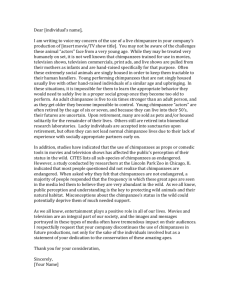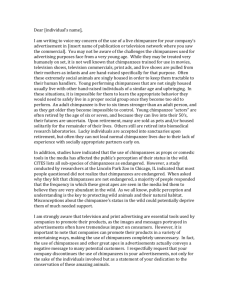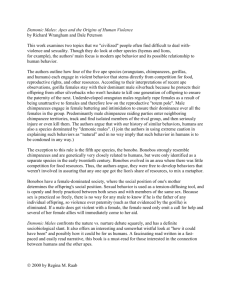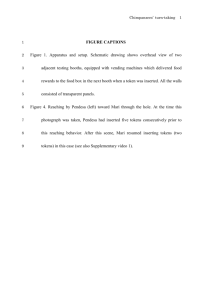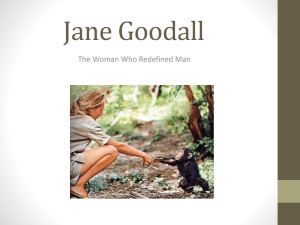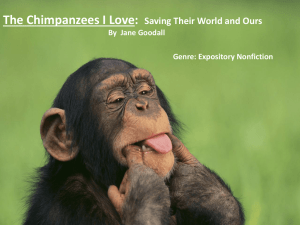Chimpanzee Social Structure
advertisement
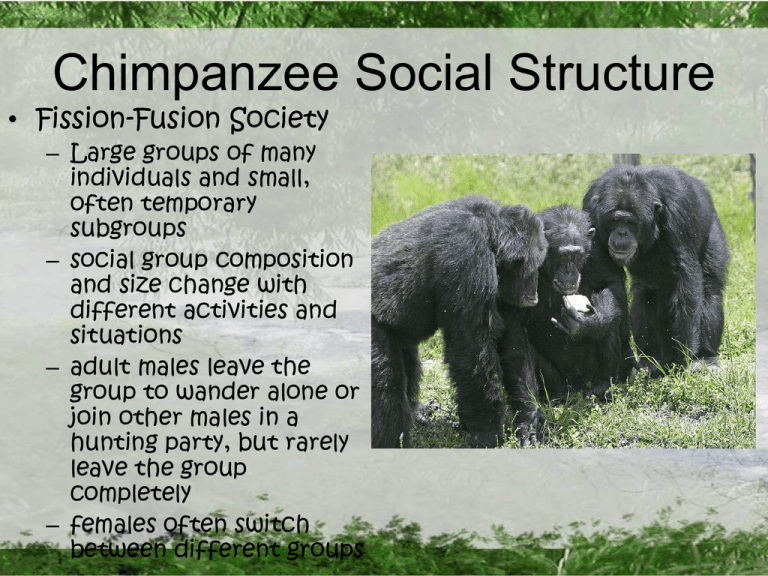
Chimpanzee Social Structure • Fission-Fusion Society – Large groups of many individuals and small, often temporary subgroups – social group composition and size change with different activities and situations – adult males leave the group to wander alone or join other males in a hunting party, but rarely leave the group completely – females often switch between different groups Chimpanzee Social Structure • Often have relatives in other groups • When different groups come together it is often a friendly encounter vs. an aggressive one • There is a major sense of autonomy of individuals Power Structure • Males are the big power holders and are dominant over females • They engaged in political activities involving scheming and physical intimidation in order to move up in power • They develop short-term alliances with other males by mutual support, sharing food, and grooming each other • They also use their intelligence to gain power in the group – They often use teamwork to frighten and impress other males and it is usually more effective than any one individual's muscles in Power Structure • Males are in charge of protecting the group and finding food • There are alpha males who often have a coalition of lesser males with them to intimidate other males • Females do not have a solid hierarchal structure but there are “better” females than others • Females often form nursery groups when Reproduction & Baby Chimpanzees • Chimpanzees are fully grown and able to reproduce at 12-13 years old. • Female chimpanzees are pregnant for about 8.5-9 months and usually have a single baby at a time; twins are rare. • Female chimpanzees carefully nurture their young. • Babies can grasp their mother's fur to ride on the mother's back at about 6 months. • After they are weaned, chimpanzees begin to build their own sleeping nests out of vegetation and not use their mother's nest anymore. • Young chimpanzees stay with their mother for about 7 years. Parental Care • Majority is the responsibility of the mothers – Critical to the survival and emotional health of youngsters • Youngsters benefit from the close relationship with their mothers in terms of food, warmth, protection, and the opportunity to learn skills • Social bond that the young have with their mother is remarkable – Even after they are adults they will continue to have affection and caring for her. – As the mother gets older the Social Life • Play is part of chimpanzees learning – It influences their overall place in their social structure • Capable of emotions that humans experience – They show great remorse when one of their own is injured or killed – Often shown expressing various types of affection towards each other. • They are very social animals and thrive on their interactions with each other. • They are able to differentiate Interesting Facts • Sharing more than 98 % of our genetic blueprint • Blood types A and O • 32 teeth • Body temperature, 98.6ºF • Cannot swim • Opposable thumbs and opposable toes • 230 days gestational period Interesting Facts Continued • Have emotions similar to those we call joy, anger, grief, sorrow, pleasure, boredom, and depression. • They also comfort and reassure one another by kissing and embracing • Use tools, such as using sticks and stones. Interesting Facts Continued • Chimpanzees in the wild have different cultures. • Today, chimpanzees are an endangered species, with as few as 150,000 left in the wild. • Use facial expressions to convey emotions. Cognitive Differences between Humans and Chimps • Chimpanzee vs. Human child learning • http://www.youtube.com/watch?v=pIAoJsS9Ix8&feature=res ults_video&playnext=1&list=PL53BC33624A8064FA • What skills are distinctly human? • http://www.youtube.com/watch?v=ZHWXYeElJWU&feature= BFa&list=PL1FE7ED4E1555578E&lf=results_video • Chimps outperform humans at memory task. • http://www.youtube.com/watch?v=nTgeLEWr614&feature=re sults_video&playnext=1&list=PL1FE7ED4E1555578E Works Cited • Shefferly, Nancy. "ADW: Pan Troglodytes: Information." Animal Diversity Web. Web. 08 Feb. 2012. <http://animaldiversity.ummz.umich.edu/site/accounts/informatio n/Pan_troglodytes.html>. • "Physical Characteristics | About Chimpanzees | Chimpanzees." The Jane Goodall Institute of Canada. Web. 08 Feb. 2012. <http://www.janegoodall.ca/about-chimp-physicalcharacteristics.php>. • "Chimpanzee Facts." Out to Africa Op Safari Door Afrika. Web. 08 Feb. 2012. <http://www.outtoafrica.nl/animals/engchimpanzee.html?zenden= 2>. • "Biological Overview of Chimpanzees." Michigan State University College of Law. Web. 08 Feb. 2012. <http://www.animallaw.info/articles/biuschimps.htm>.

